NOYAFA NF-8209 Network Cable Tester is used to measure cable continuity. It enables the measurement of connection errors in UTP / STP twisted pairs. The device is manufactured by SHENZHEN NOYAFA TECHNOLOGY CO., LTD and sold with several different brand names.
NF-8209 Main features:
1. Two scan modes selectable: AC filter & Non AC filter.
2. Detect AC voltage presence (50V-1000V).
3. Test physical status for STP, UTP lan cable.
4. Measure cable length accurately , the range is 200m.
5. Hub blink for locating network port by the flashing port light on Hub / Switch. Available to 10M/100M/1000M Hub/ switch.
6. PoE testing : identify which pins are providing power and detect how much voltage, identify which the type of PSE (at/af standard).
The kit includes:
- emitter,
- reciever,
- remote,
- connection wires,
- soft case
The main tester is cased 130*70*28mm ABS plastic box and it has LCD display that is 128*64 Dot-matrix with back-light. The tester main unit is powered with three AAA batteries (Max working current less than 150mA). The tester has adjustable auto-off time (15min、30min、60min、OFF).
The device is protected against line voltages DC48V 5mA. Material: ABS
The cable tracer receiver is a separate device in 210*43*27mm ABS plastic case. It has adjustable sensitivity and adjustable operating modes (analog/digital/NCV). The receiver has built-in LED lamp and it is powered with 9V battery (max current less than 100 mA). The receiver has AC Voltage detecting mode: if the “NCV”indicator is light on, then you can use the receiver to detect AC voltage presence.
For testing cable wiring correctness there us a wiremap adapter (65*37*23mm) that is connected to the other end of the cable being tested. Wiremap adapter is powered through RJ-45 connector (the mains tester supplies needed power). The wiremap adapter has Voltage protection DC48V 5mA. The wiremap tester can be used to test physical status for STP, UTP lan cable.
The device comes with a short but useful leaflet manual that tells the most important details. You an find a copy of that Manual on-line.
The products worked as expected. It’s easy to read the display and all the functions I’ve tried worked as expected. Here are some more detailed description of different features.
Wire map test
A wire mapping tester transmits signals through each wire in a copper twisted-pair cable to determine if it is connected to the correct pin at each end. With this tester the wire map testing is performed by connecting the cable being tested between CONT port and WIREMAP testing box. Wire map testing is said to work up to 600 meters according to the device specifications (in my tests it worked well up to 181 meters, the longest cable I had access to on my test lab). The cable tester can test open, short, cross, etc. for STP and UTP cable.
Virtually every Ethernet cable tester can perform a wire map test. While it doesn’t verify bandwidth performance to tell us if a cable plant can support a certain Ethernet application, wire map testing is the first test to even let you know that you have continuity and that each conductor of a four-pair cable is connected correctly to the corresponding pin at the far end. To do this, wire map testing typically tests for open, shorts, reversed pairs, crossed pairs and split pairs. One of the most difficult wire map tests to identify is a split pair, and the wire map testing mode on this tester does not seem to have split pair testing in it (but cable length scanner mode seems to be able to spot split pair on my tests – on my test showed length 0 meters for split pair).
Cable length testing
This cable length meter is a feature for determining the cable length network cable. NF-8209 can measure cable length and locate fault distance for LANcable from the range up to 200m. The cable measurement tested is designed for LAN cabling terminated to RJ-45 connectors. This type of cabling has four wire pairs, and the meter measures the length of each of them. This tester is designed to support cable types CAT5、CAT6 (STP & UTP). The measurement range is 2~200m with accuracy of ±1.6m. The meter is designed to work in situations where cable being measured is connected to the tester on one end the other end is left open.
The length measurement technology used in this instrument is based on Time Domain Reflectometry (TDR). A time-domain reflectometer (TDR) is an electronic instrument used to determine the characteristics of electrical lines by observing reflected waveforms. It can be used to characterize and locate faults in metallic cables (for example, twisted pair wire or coaxial cable). I have written several blog posts blog posts on TDR if you want to learn more on that.
The Time Domain Reflectometry can be used to determine cable lengths, cable faults, cable breaks, short circuits and cable crushes. With the TDR method, the device sends a pulse onto the cable, which is then reflected by cable other end (or faults) and sent back to the device. Impulse passes through the cable section until it is reflected at the open cable end and returns to the beginning of the cable and the measuring device. The signal reflection happens when there is considerable impedance mismatch in the cable (open cable end or cable short circuit). The instrument calculates the cable lengths or fault location based on the time taken to return to the transmitter. This time is then converted into a length measurement using the cable parameters and pulse settings (which are fixed in this device for CAT5 and CAT6 cable). To ensure that the length measurement is as accurate as possible, the correct value of the propagation velocity (VP value) must be used in calculations. The more precise this value is, the more accurately the cable length is displayed.
The cable length tester supports based on documentation cable types CAT5e,CAT6,CAT6a(STP&UTP) network cables.
It measures the length of all four pairs of the cable. If the cable has less than four pairs, it gives reading on those pairs that exist. The cable being tested is designed so that the test is performed with cable other end open. The testing does not work if on the other cable ends is connected to device or switch Ethernet port. In addition to the cable end open, the testing can also work if the other end of the cable end is shorted together.
The supported test range is 2.5m~200m. The length isn’t the most accurate, but its good enough, as the resolution is around 1.5-2 meters. The length measurement error depends on the actual cable specifications (speed of signal travel that can vary somewhat between different cable types). In my tests when I measured 100 meters of CAT 5e cable, I got measurement reading of 101.6 meters for all wire pairs. The device is of course NOT a professional tool for very accurate measurements or installed cable certification, but it is a well working test tool useful to has on your tool case when you need to do network cable debugging. If the problem isn’t obvious at the point of termination, there could be a cut or break in the cable, which would also show the length of one pair being much shorter than the others. The length estimation is good enough to check you are within spec, and it will make sure you have no reversed pairs, although it’s not as good as a formal record of signal loss in dB etc. The cable meter seems to be able to determine also (at least some few I tested) split pair problems showing cable length of 0 meters for the pair that was not properly twisted together.
I found with experimenting that this cable length measurement feature seems to work also with also some other cable types than CAT 5 and CAT 6 twisted pair cables. I tried the tester also with RJ-45 to BNC adapter (just one RJ-45 wire pair directly wired to BNC connector). With this adapter the tester could also measure the approximate length of some 50 ohm or 75 ohms coaxial cables. The length measurement of the coaxial cable is somewhat less accurate than with CAT5 cable, because the propagation velocity (VP value) in coaxial cable is somewhat different and there is more variation on signal speed on the coaxial cable than in CAT5/6 cables.
I also tested cable length measurement feature with XLR microphone cables, and I also got readings in somewhat on right direction, but with quite significant error: I tested with about 8 meters long old microphone cable and get length reading of 12 meters.
PoE testing
Power over Ethernet (PoE) is a feature that allows electrical power to be carried by network cables over an existing data connection. The PoE technology is quite complicated and there are several PoE standard versions, so many things can go wrong in real life applications so tests tools are needed for debugging. NF-8209 has several useful PoE testing features like PoE detection and identify the standard (IEEE802.3at/af / non standard). Test the information of PoE device include technical specifications such as PoE voltage, power supply polarity, power supply mode. It can also identify which the type of PSE (at/af standard) if power supplying device is standard PoE device. If it is no-standard PoE device, it only display “non-standard”.
POE information testing can identify which pins are providing power and detect how much voltage, and which type of the PSE (at/af standard) from DC range 5V to 60V standard or non-standard POE switch. The voltage test range is DC 5~60V.
Link test and port flashing
NF-8209 support Ethernet link testing and Ethernet port LED flashing. This is designed to test that connectivity from end device location works to the Ethernet switch. By selecting FLASH test, the tester first determines if there is Ethernet switch on the other end of the cable and then determines the Ethernet connections parameters like connection speed (10M/100M/1G) and if connection is working in full-duplex or half-duplex mode.
The FLASH test also includes Hub blink feature to locate network port on the Ethernet switch connected to the tester. When you leave the tester connected to the cable, it makes the link LED on the Ethernet switch/router/hub to flash on/off. In this way you can easily see where the other end of cable goes to. The blink/flash function is very handy.
Cable tracer
For cable tracing the product can be rated as a midrange toner with analog and digital modes. The device list three scan modes: Digital model/ Analog mode/ PoE mode. Both analog and digital toning work OK. The documentation was not clear what the PoE mode should do. The main unit works as signal sender and a separate receiver is used to listen to the signal. There is a separate RJ45 socket in the main tester for the signal feed for searching for cables, a crocodile clip adapter is included, as is a short RJ45 patch cable.
On signal sending the manufacturer gives the following data:
Max. signal voltage 8Vp-p
Frequency 130KHz
AC filter Yes
Max range 600m
The analog tracing mode sends analog sound (around 1 kHz variable tone) to the line for the inductive amplifier to listen. Inductive amplifier is a type of test instrument that does not require electrical contact to detect an AC wire under voltage. The conventional use of the inductive amplifier is finding the location of hidden wires and breaks in them. Inductive amplifiers can also be used to find an individual cable pair in a telephone cross connect or cable head when used in conjunction with a tone generator. In the receiver when you are near the right wire, you will hear the sent tone and some noise,
The digital mode works in the same way, but instead of the analog signal the tester sends out faster digital bitstream to the line, and the receiver when it detects that signal informs the user that signal has been detected (with tone and LED).
The signal receiver has three settings Analog, Digital and NCV. When used to network cable tracing, the Analog/Digital needs to match what the sender sends. NCV (Non-Contact Voltage) is designed to detect AC voltage presence 50V-1000V. You can press the “Power/Set” button on the receiver, if the “NCV”indicator is light on, then you can use the receiver to detect AC voltage presence.
The cable search function works decently, but is not particularly good.
The documentation of it is not very good.
Version info on tested unit
Other test comments:
KOLSOL NF-8209 Network Tester Overview and Review
More videos:
https://www.youtube.com/watch?v=pzAKfdF5MtQ
https://www.youtube.com/watch?v=KoFh0O3InBo
Anyone who has something to do with the network, if necessary puts up sockets and crimps cables themselves or just wants to analyze their existing “cables” this is a decent tester for occasional uses. It packs many features to the same package at very attractive price point. Using traditional professional instruments you would need to invest easily many hundred to thousand euros to get tester that does that all. Sufficient for occasional enthusiast use, but if I were to be using it monthly I would probably treat myself something more professional.
Brilliant unit for the price, ideal for someone who needs a cheap solution to doing small to medium amounts of networking. Here everyone who technically knows what he/she is doing, for 35-80 euros, this is an useful, useful and target-oriented device for network measurements needed for network debugging. This is Actually a good tool for many tasks, and I was pleasantly surprised on the features it provides.
There are also downsides for cheap price. Brilliant unit for the price, ideal for someone who needs a cheap solution to doing small to medium amounts of networking. It is made of cheap plastic, so I wouldn’t expect it to do well throwing it around, but in that sense you get what you pay for.The documentation is quite terrible as well, though I pretty much expected that.
In this price class if you have a little expertise and are aware of the limits, you will still get a lot of information with this device.
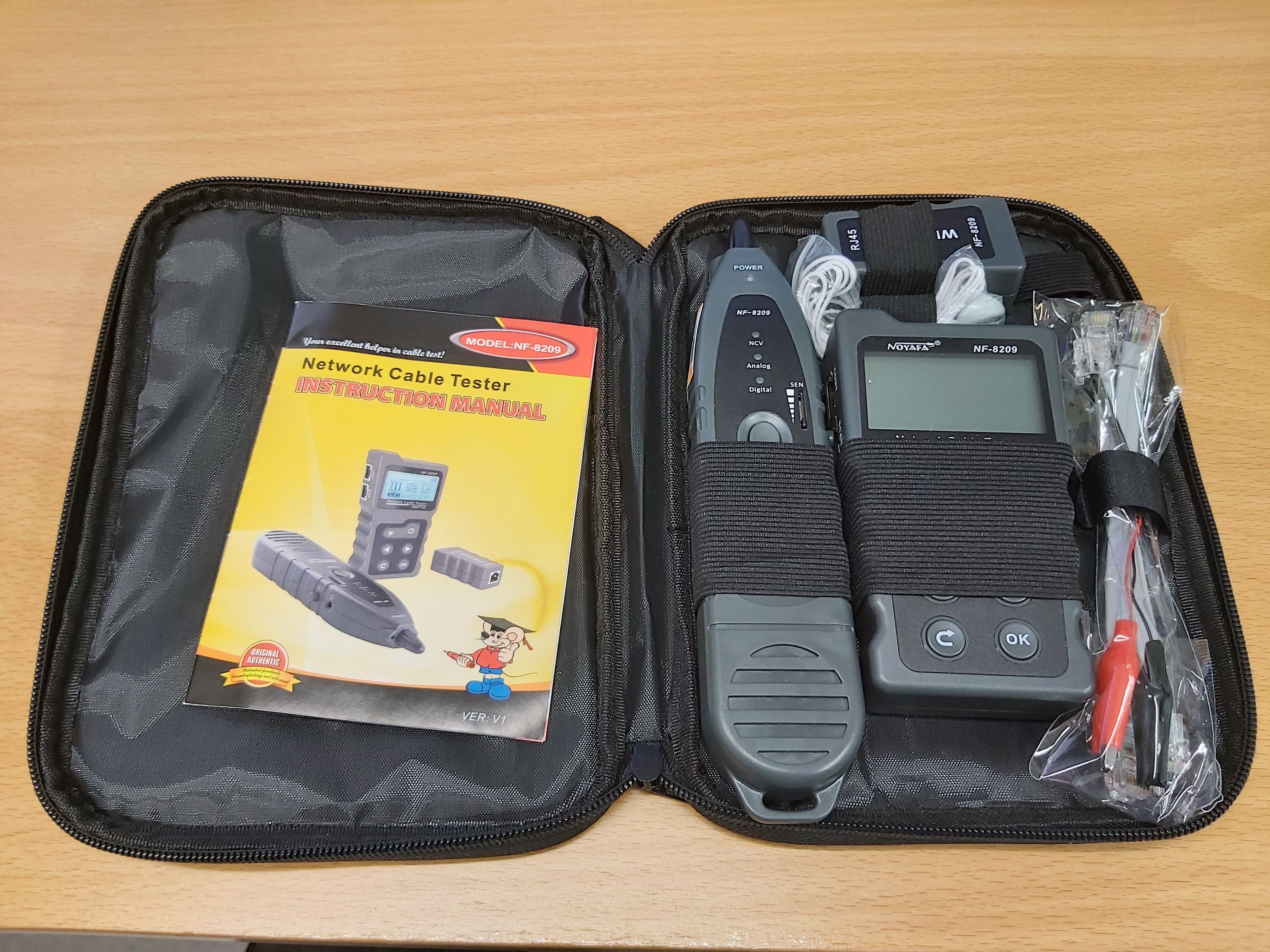
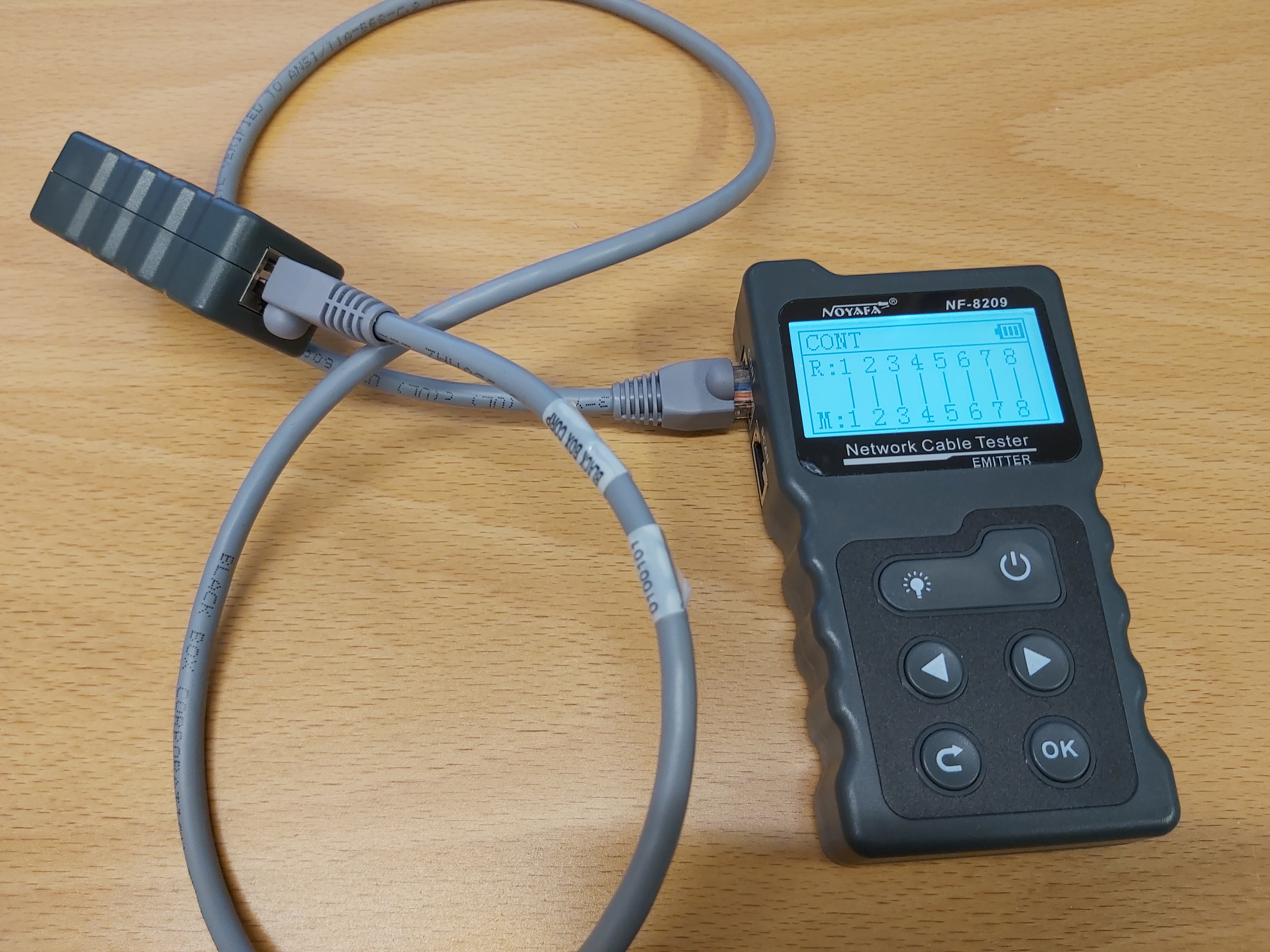
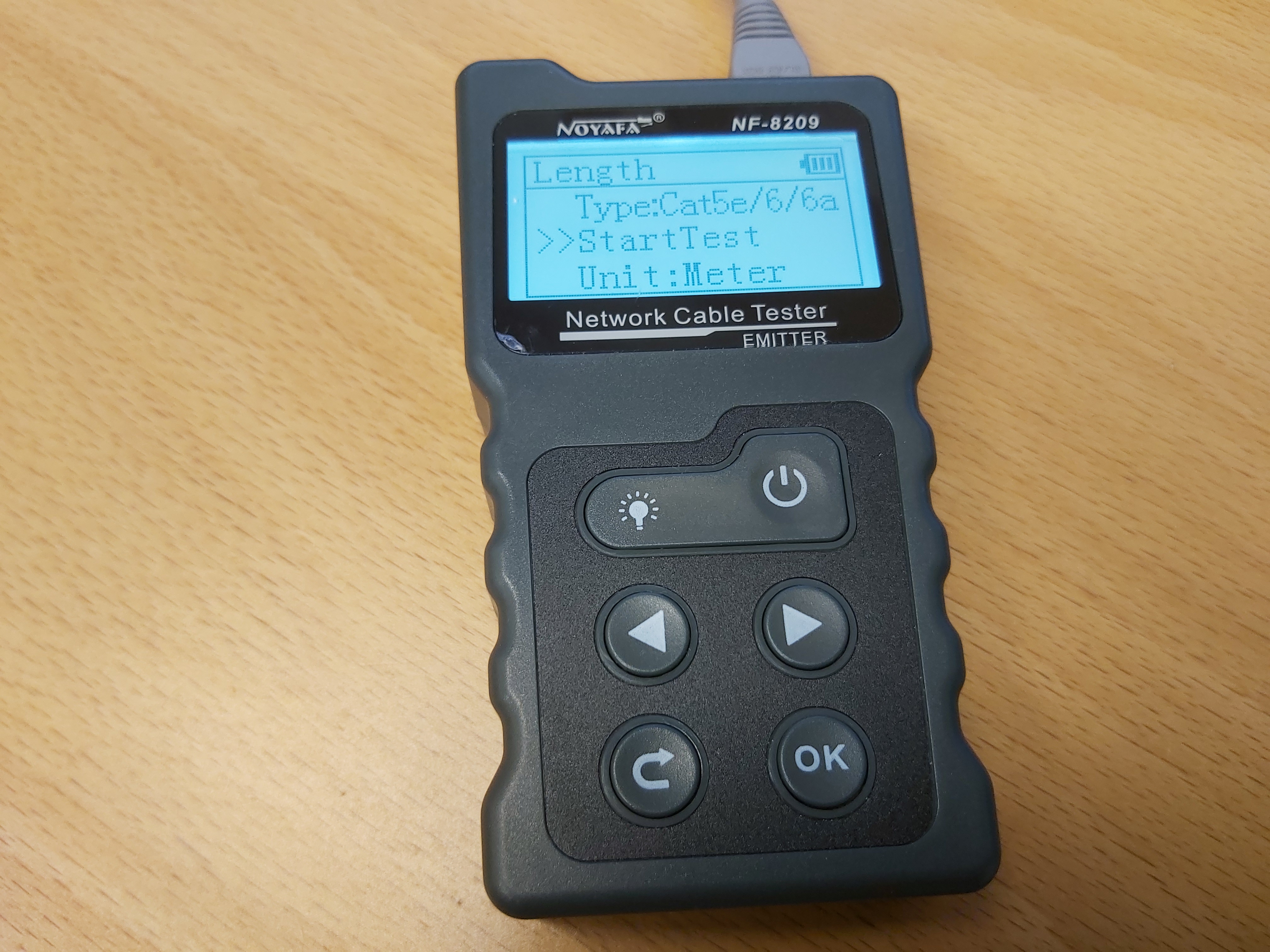
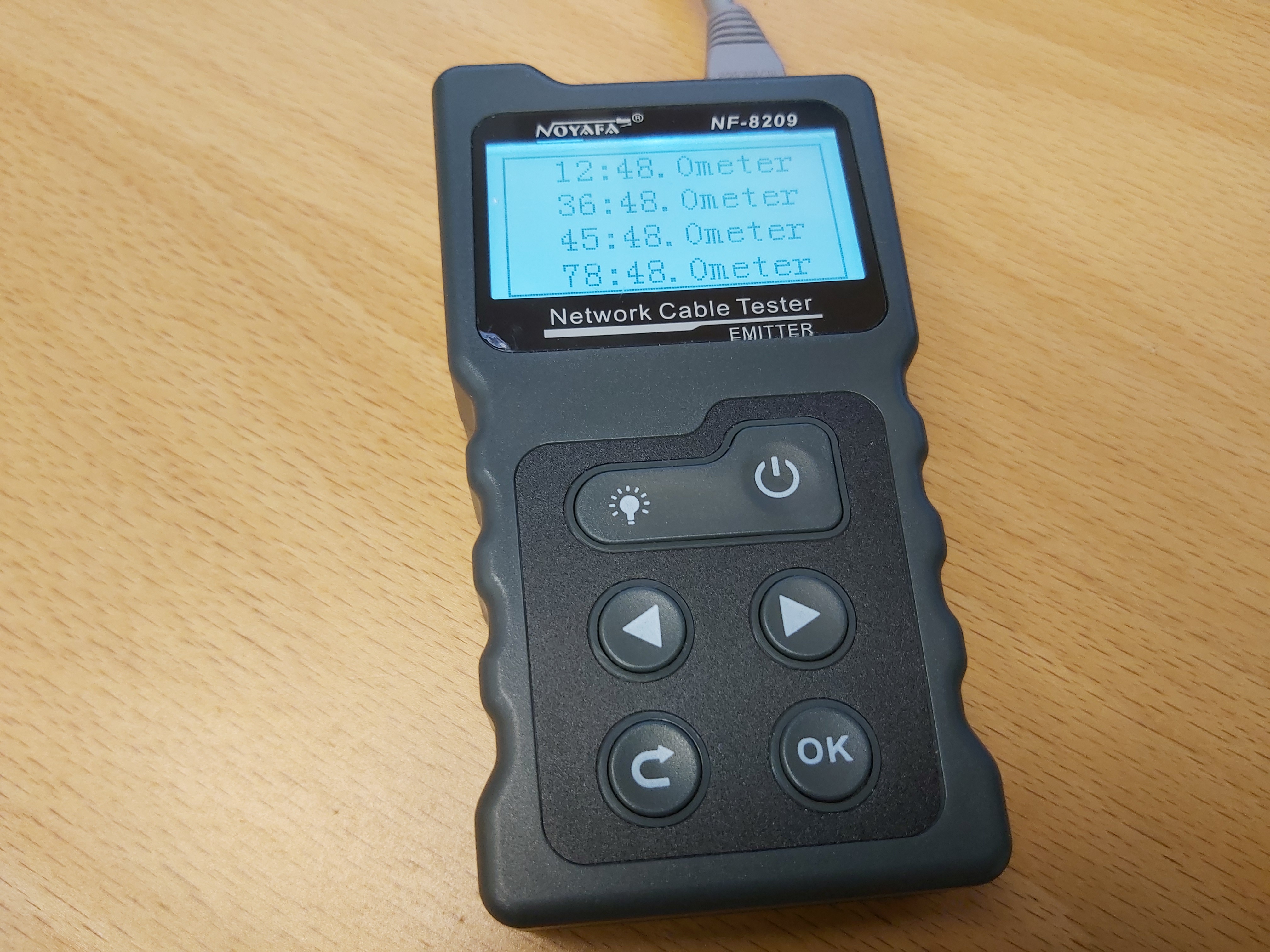
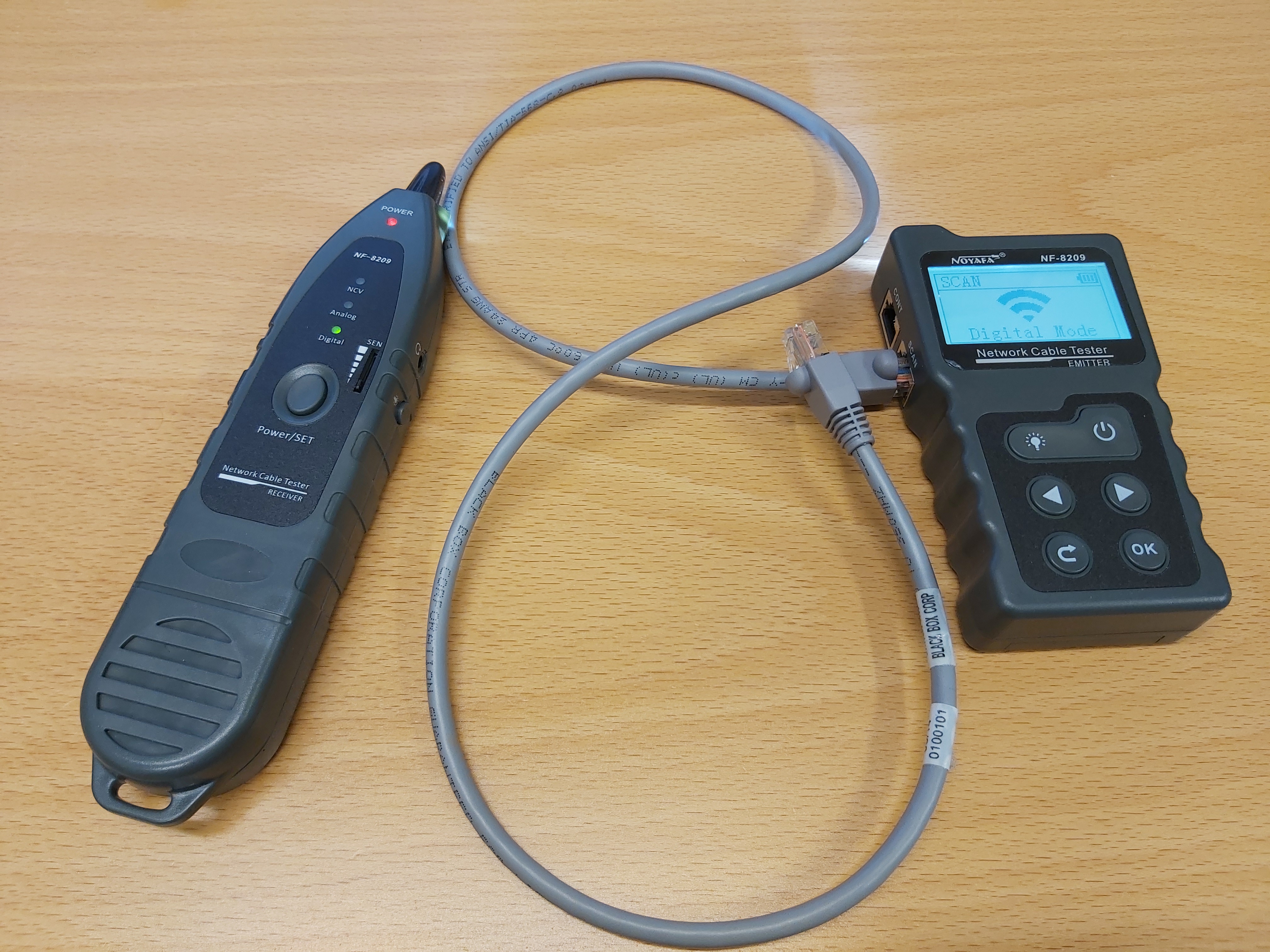
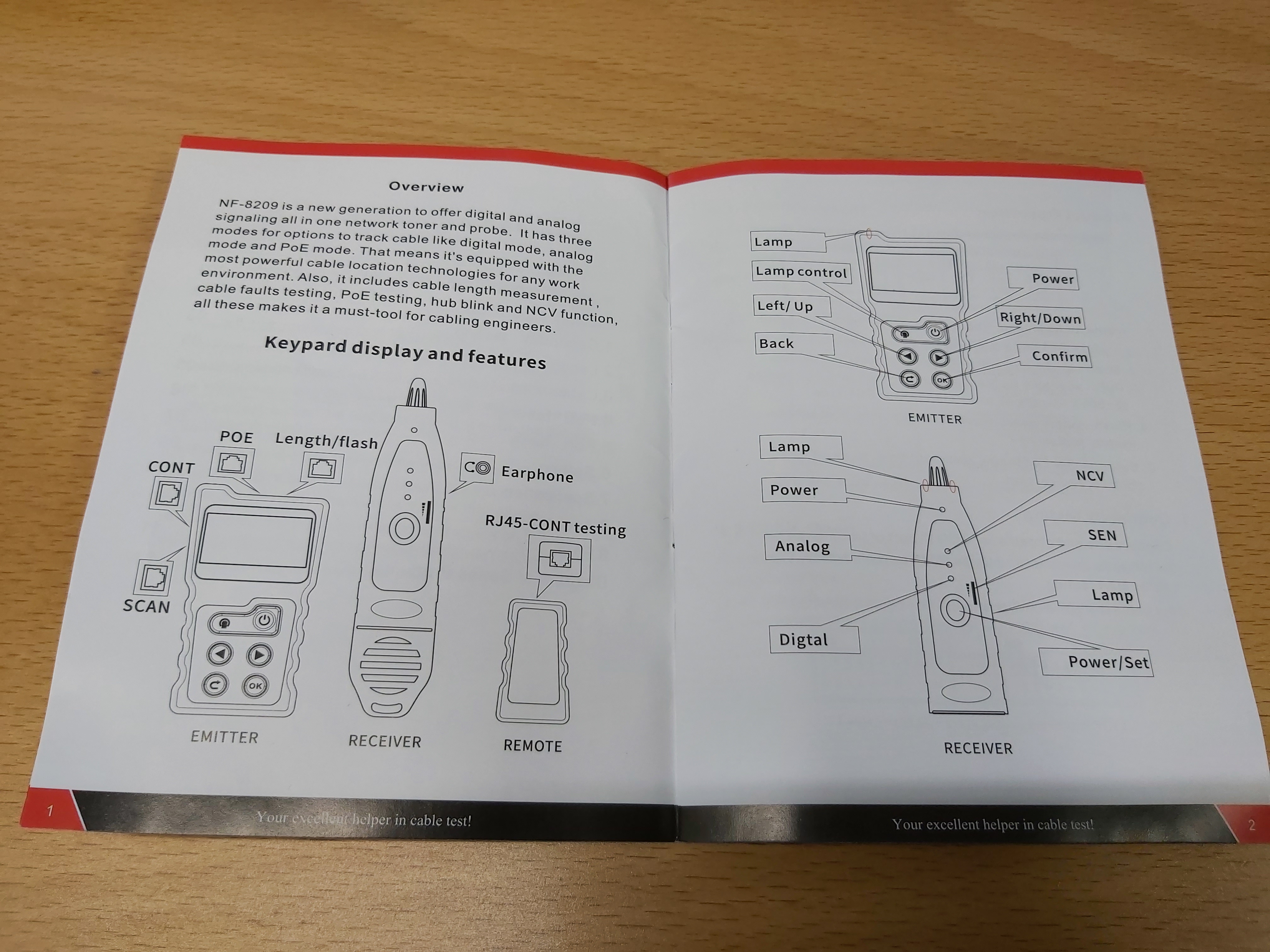
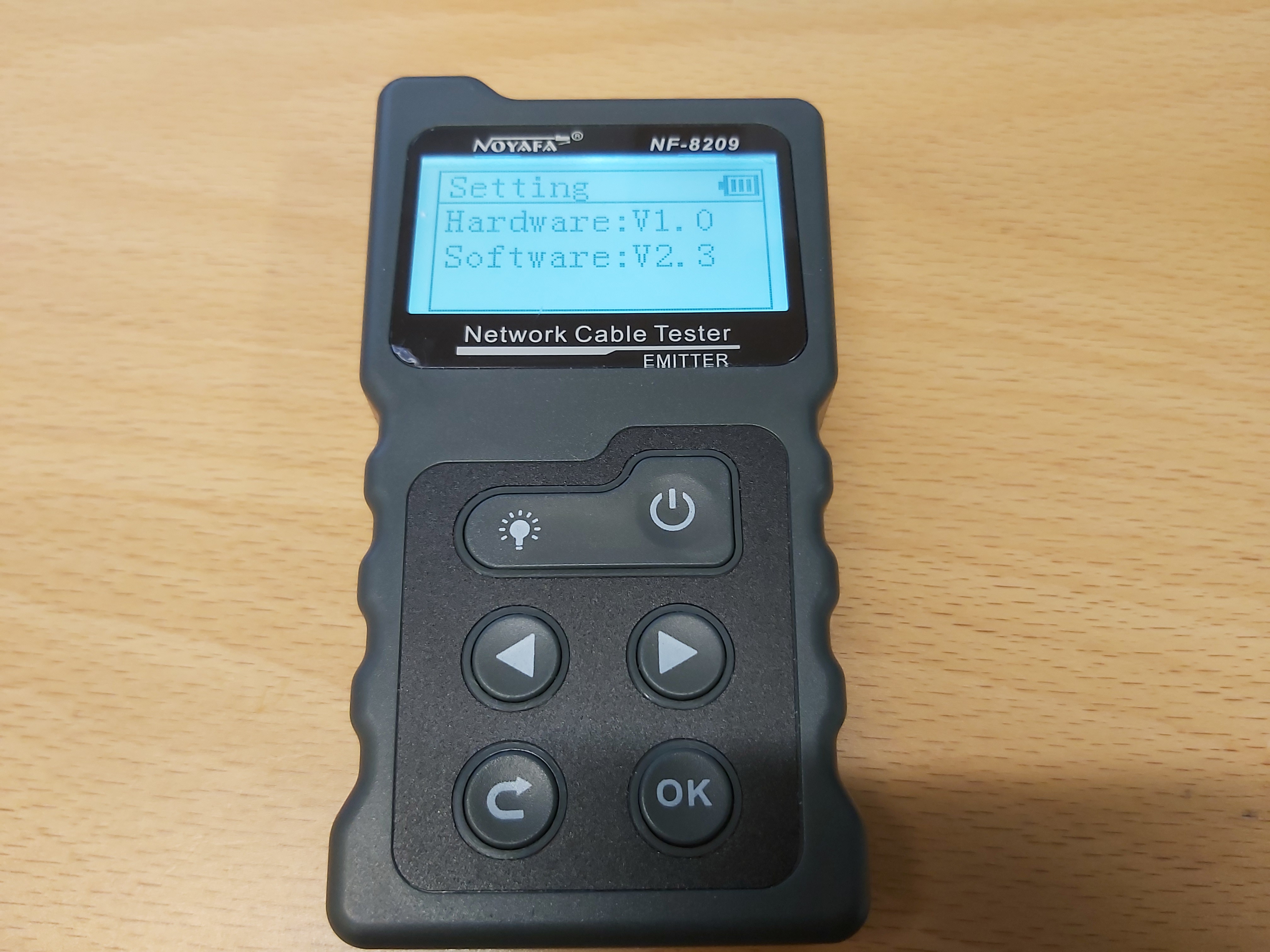
11 Comments
Tomi Engdahl says:
I tested 10 meters of RG59 coaxial cable and got length reading of 10.4 meters.
I tested the cable length measurement with flexible 230V AC mains cable (3×1.5mm2 with rubber insulation). The meter gave length reading of 12 meters for 10 meters long extension cable I tested.
Tomi Engdahl says:
Measured 25 meters long coiled flexible 230V AC mains extension cable (3×1.5mm2 with PVC insulation)
I got result 31.2 meters with the tester.
Tomi Engdahl says:
2020 NOYAFA NEW ITEM:NF 8209 LCD wire tracker
https://www.youtube.com/watch?v=pzAKfdF5MtQ
Main features
1. Two scan modes selectable: AC filter & Non AC filter
2. Detect AC voltage presence (50V-1000V).
3. Test physical status for STP, UTP lan cable.
4. Measure cable length accurately , the range is 200m.
5. Hub blink for locating network port by the flashing port light on Hub / Switch. Available to 10M/100M/1000M Hub/ switch.
6. PoE testing : identify which pins are providing power and detect how much voltage, identify which the type of PSE (at/af standard)
Tomi Engdahl says:
Top 5: Best Wire Tracer of 2021| Network Cable Tester
https://www.youtube.com/watch?v=vZkF8rSxnPM
1. Product name: Mastech MS6818 Portable Professional Wire Cable Tracker
2. Product name: NOYAFA NF-8601S TDR Tester Network Cable Tester Tracker
3. Product name: NOYAFA NF-8209 LCD Display Measure Length Lan Cable POE Wire Checker
4. Product name: NOYAFA NF-858C Trace Cable Line Locator Portable Wire Tracker
5. Product name: NOYAFA NF-308 Measure Network LAN Cable Length Cables
Tomi Engdahl says:
Another network cable tester tested:
Network cable tester teardown
https://www.youtube.com/watch?v=pe7kXAF_FW8
Network cable testers from eBay. Buy cheap, buy twice!
Save your money and buy a different model, as it doesn’t take much to kill these ones.
INDEX
0:10 Introduction: Cheap network cable testers from eBay
0:25 What’s fried them? Probably not PoE
1:17 How they’re supposed to work
3:08 How they’re NOT supposed to work
3:35 What’s inside?
4:12 Receiver schematic
4:43 Emitter schematic
5:00 Wire mapper theory of operation
6:32 Tone generator theory of operation
7:41 Scoping the tone outputs
8:02 Design flaw: is the tone generator cooking the wire mapper?
8:40 A simple suggestion for improvement
9:43 Scoping the faulty tone generators
9:58 Hotspot spotting with a thermal camera
11:40 Power consumption testing
13:37 Testing with tone generator removed
14:50 Testing with tone generator re-added and wire mapper removed
15:56 Removing even more tone generator
16:15 Wire mapping into a network switch? No problem
16:52 Tone generating into a network switch? Magic smoke time!
17:43 Conclusions
Tomi Engdahl says:
https://packetlife.net/blog/2008/nov/12/measuring-cable-length/
Tomi Engdahl says:
https://community.spiceworks.com/topic/2023536-what-equipment-can-determine-length-of-a-cat5e-cable-run
You may already know this, but many Aruba/HP/Procurve switches have TDR built-in. You can run a cable diagnostic on the port and it will tell you how long until a cable break (unconnected end, for example) within a reasonable precision (a few yards).
https://community.arubanetworks.com/t5/Wired-Networks/Time-Domain-Reflectometer-in-Aruba-Switch/ta-p/233818
I know some of the recent firmware upgrades have added this to some of the Procurve (rebranded to Aruba) switches. It’s obviously not going to be in much older switches. Check the particular switch docs for the syntax.
pp2k says:
Hello Tony,
can it be safely used to track and test cables while connected to PoE powered switchports? Any risk to damage the tool or the switchport doing so?
Thanks
Tomi Engdahl says:
Can’t say for sure if all ports are safe to use with PoE powered switch ports.
The PoE port in tester is designed to work with PoE systems, so it is safe to connect PoE powered systems (both IEEE standard compliant and proprietary PoE systems).
The length/flash port also seems to be built (according to my measurements) that it would be OK to connect it to port with PoE as well. I have not tested in practice.
For the SCAN port the manual says that it is compatible with PoE with one operating mode specifically to be used with PoE networks.
It might not be wise to connect the CONT port to anything else than supplied wiremap plug for wire map testing. I know several other cable wiremap testers that would not like be connected to network with PoE in it (would potentially fry the tester), but I am not sure if this CONT port is properly protected against PoE voltages or not in this tester.
Tomi Engdahl says:
Twisted Pair Cabling Measurements
Wire Map
Delay/Skew
Resistance Unbalance
Loop Resistance
Transverse Conversion Loss
Return Loss
Insertion Loss, NEXT, FEXT, ACRN, ACRF
Tomi Engdahl says:
This Budget Network Cable Tester is AWESOME! – Noyafa NF-8209S
https://www.youtube.com/watch?v=ZbJHU7kIHDA